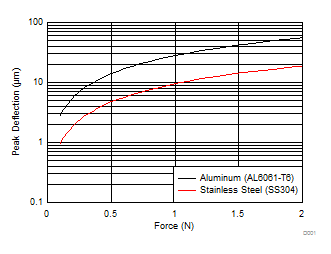SNOA951 June 2016 LDC1312 , LDC1312-Q1 , LDC1314 , LDC1314-Q1 , LDC1612 , LDC1612-Q1 , LDC1614 , LDC1614-Q1
- Inductive Sensing Touch-On-Metal Buttons Design Guide
3.1.1.1 Metal Composition
The material choice can have a large impact on how much force is required to achieve the required deflection at a given metal thickness. The key parameter is Young’s modulus, which is a measure of the elasticity of the metal and is measured in units of pascal (Pa). Materials with a lower Young’s Modulus are typically more flexible. Aluminum (AL6061-T6) has a Young’s modulus of 68.9 GPa, while Stainless Steel (SS304) has a higher Young’s modulus of 203 GPa, which makes it about 3 times less flexible than aluminum. Aluminum is an excellent material choice for inductive sensing because it is both flexible and asserts a high inductance change on an inductive sensing coil. Materials such as SS304, can also be used and provide robust results. The difference in deflection for a given amount of pressure between the two materials is shown in Figure 6.
 Figure 6. Force vs Peak Deflection for Different Materials, Diameter = 20 mm, Thickness = 0.25 mm
Figure 6. Force vs Peak Deflection for Different Materials, Diameter = 20 mm, Thickness = 0.25 mm